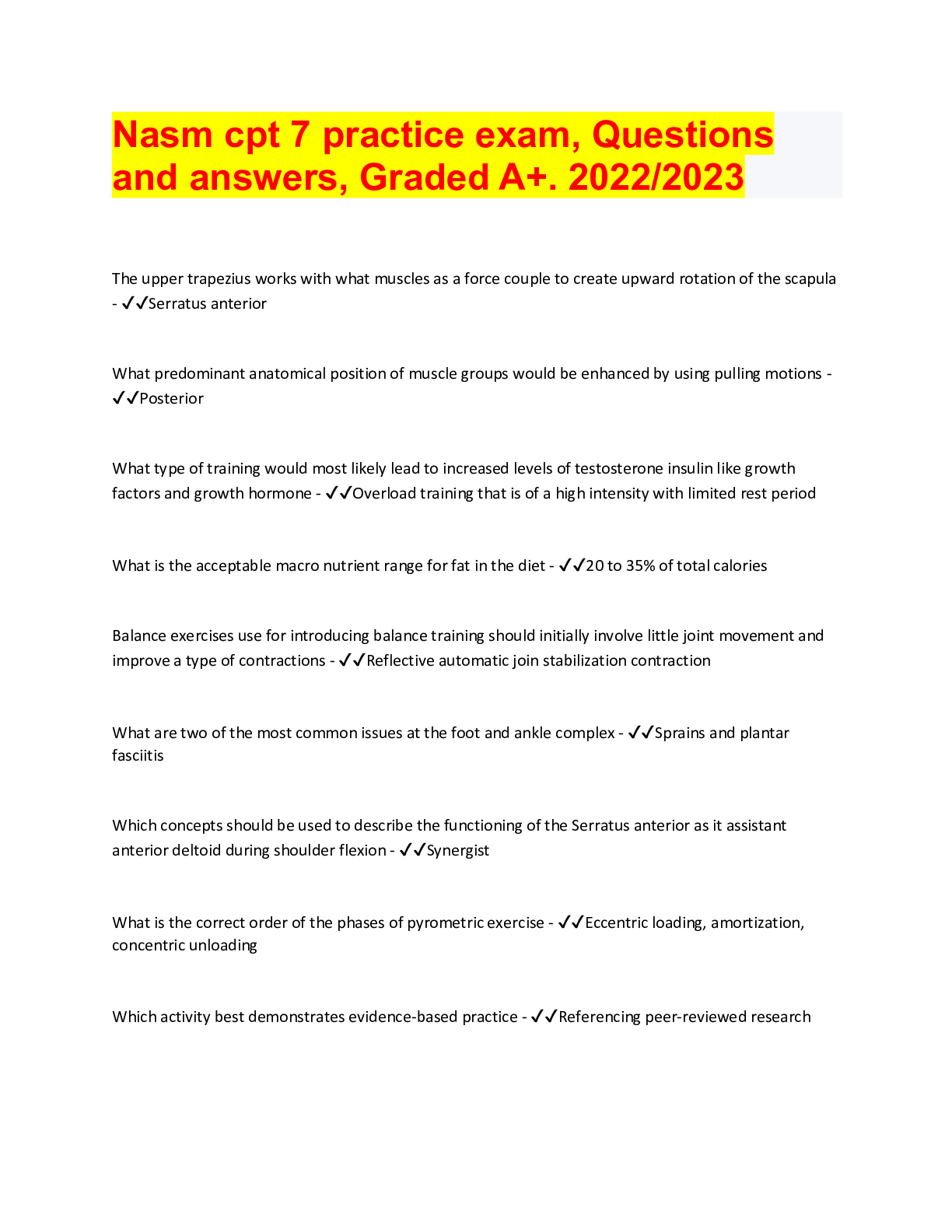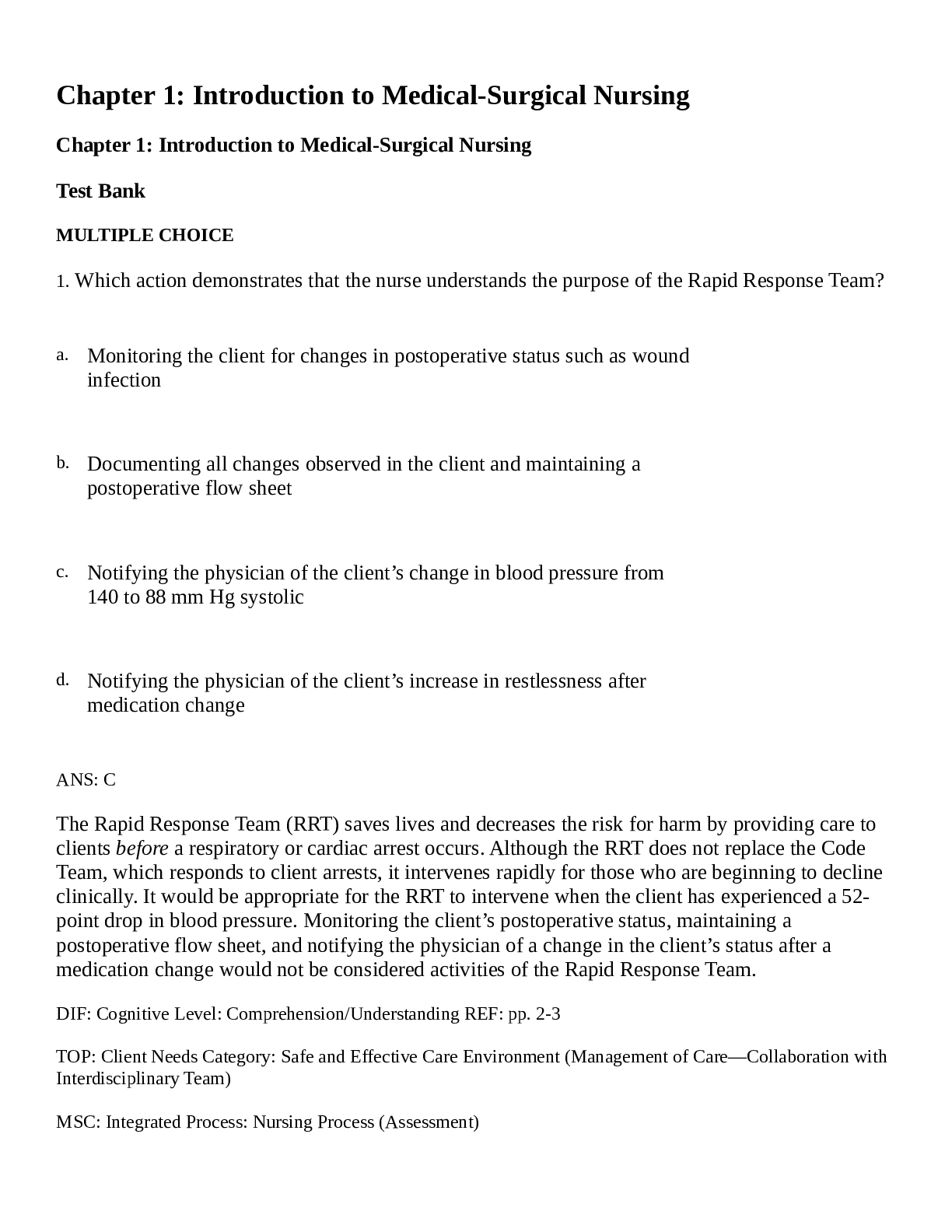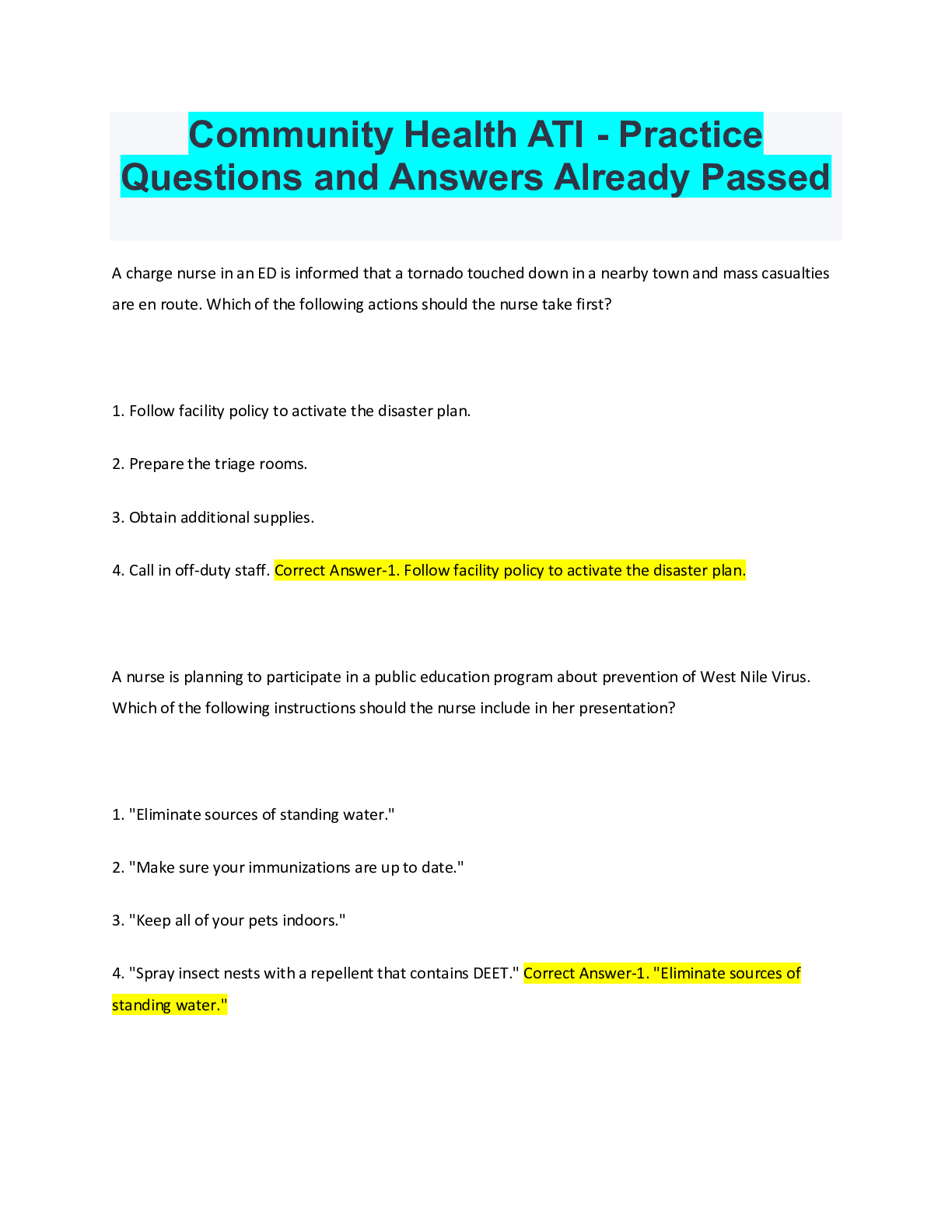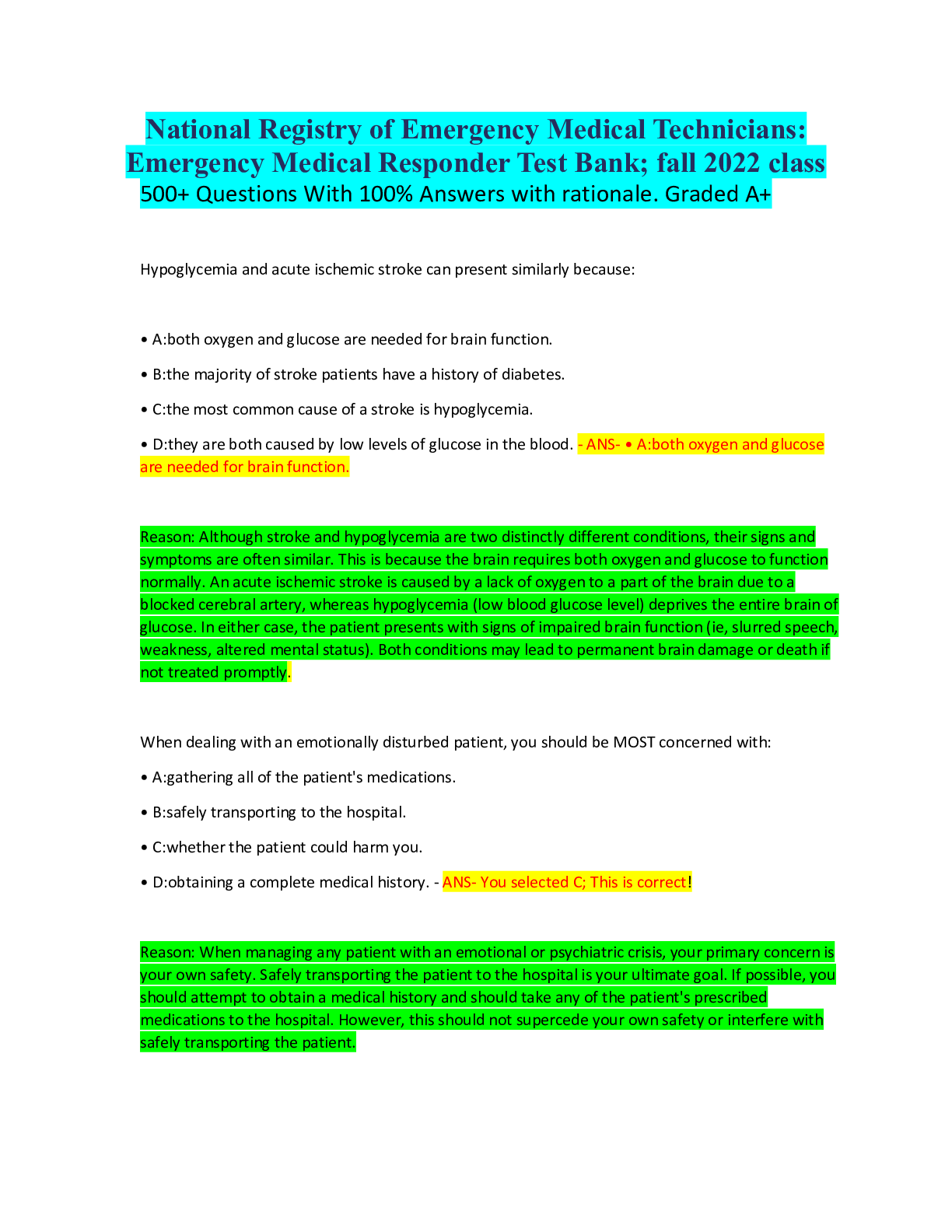NASM CPT Questions Bank and answers, 2022 update
Document Content and Description Below
NASM CPT Questions Bank and answers, 2022 update Name the structures that make up the lumbo-pelvic-hip complex (LPHC). - ✔✔Lumbar spine, pelvic girdle, abdomen, and hip joint Dysfuncti... on within the connective tissue of the kinetic chain that is treated by the body as an injury, initiating this repair process. - ✔✔Cumulative injury cycle Name four core-strength exercises. - ✔✔Ball Crunch, Back Extensions, Reverse Crunch, Cable Rotations The type of flexibility training that applies gentle force to an adhesion, altering the elastic muscle fibers from a bundled position to a straighter alignment with the direction of the muscle and/or fascia. - ✔✔Self-myofascial release Exercises in the core-stabilization level are identified through these characteristics. - ✔✔They involve little motion through the spine and pelvis What are four common ways a stressor causes breakdown or injury? - ✔✔Stress fractures, muscle strains, joint pain, emotional fatigue Name four core-stabilization exercises. - ✔✔Marching, Floor Bridge, Floor Prone Cobra, Prone Iso-abs Law stating that soft tissue models along the lines of stress. - ✔✔Davis's law Referred to as a co-contraction of global muscles, such as the rectus abdominis, external obliques, and quadratus lumborum. - ✔✔Bracing It is critical that the core training program is designed to achieve these three functional outcomes in the right order. - ✔✔1. Intervertebral stability, 2. Lumbo-pelvic stability, 3. Movement efficiency. What are the proper backside mechanics during sprinting? - ✔✔Ankle plantar flexion, knee extension, hip extension, and neutral pelvis What are the proper frontside mechanics during sprinting? - ✔✔Ankle dorsiflexion, knee flexion, hip flexion, and neutral pelvis The ability to accelerate, decelerate, stabilize, and change direction quickly, while maintaining proper posture. - ✔✔Agility The ability to react and change body position with maximum rate for force production, in all planes of motion and from all body positions, during functional activities. - ✔✔Quickness The ability to move the body in one intended direction as fast as possible. - ✔✔Speed Name four core-power exercises. - ✔✔Rotation Chest Pass, Ball Medicine Pullover Throw, Front Medicine Ball Oblique Throw, Soccer Throw The ability of the body to produce high levels of force for prolonged periods of time. - ✔✔Muscular endurance What is a component of core-power exercises that make them easy to identify? - ✔✔Explosive movements with medicine balls Name five balance-stabilization exercises. - ✔✔Single-leg Balance, Single-leg Balance Reach, Single-leg Hip Internal and External Rotation, Single-leg Lift and Chop, Single-leg Throw and Catch Name five balance-strength exercises. - ✔✔Single-leg Squat, Single-leg Squat Touchdown, Single-leg Romanian Deadlift, Step-up to Balance, Multiplanar Lunge to Balance Name three balance-power exercises. - ✔✔Multiplanar Hop with Stabilization, Multiplanar Single-leg Box Hop-up with Stabilization, Multiplanar Single-leg Box Hop-down with Stabilization What are four plyometric-stabilization exercises? - ✔✔SQUAT JUMP WITH STABILIZATION, BOX JUMP-UP WITH STABILIZATION, BOX JUMP-DOWN WITH STABILIZATION, MULTIPLANAR JUMP WITH STABILIZATION. Name four plyometric-strength exercises. - ✔✔Squat Jump, Tuck Jump, Butt Kick, Power Step-up Name three plyometric-power exercises. - ✔✔Ice Skater, Single-leg Power Step-up, Proprioceptive Plyometrics Exercises that use quick powerful movements involving an eccentric action immediately followed by an explosive concentric contraction. - ✔✔Plyometric training Body position progressions in balance training. - ✔✔TWO-LEG STABLE, SINGLE-LEG STABLE, TWO-LEG UNSTABLE, SINGLE-LEG Give examples of chest exercises used in the Stabilization Level of the OPT model. - ✔✔Ball Dumbbell Chest Press, Push-up, Ball Push-up: hands on the ball, Standing Cable Chest Press What are the two techniques used in corrective flexibility according to the integrated flexibility continuum? - ✔✔SMR (self-myofascial release) and static stretching Give examples of total-body power exercises - ✔✔Two-arm Push Press, Barbell Clean, Dumbbell Snatch, Squat Thrust, Kettlebell Hang, Clean and Jerk What is the minimum amount of time static stretches should be held? - ✔✔30 seconds Name two different leg-stabilization exercises. - ✔✔Ball Squat and Multiplanar Step-up to Balance What are three things that a client should have established prior to incorporating a dynamic stretching program? - ✔✔Good levels of tissue extensibility, core stability, and balance capabilities Name two strength level exercises for the legs. - ✔✔Leg Press and Barbell Squat Name two power level exercises for the legs. - ✔✔Squat Jump and Tuck Jump Give 3 examples of shoulder power exercises. - ✔✔Front Medicine Ball Oblique Throw, Overhead Medicine Ball Throw, Speed Tubing Shoulder Press Give examples of total-body strength exercises. - ✔✔Lunge to Two-arm Dumbbell Press; Squat, Curl, to Two-arm Press; Step-up to Overhead Press: sagittal plane; Romanian Deadlift, Shrug to Calf Raise Based on the exercise selection continuum what exercises should be selected for the adaptation of stabilization? - ✔✔Total-body, multi-joint or single joint, controlled unstable Total-body, multi-joint or single joint, controlled unstable - ✔✔Marching, Floor Bridge, Floor Prone Cobra, Prone Iso-abs Give four examples of core-strength exercises. - ✔✔Ball Crunches, Back Extensions, Reverse Crunches, Cable Rotations Body position progressions used for balance training. - ✔✔1. Two-leg stable 2. Single-leg stable 3. Two-legs unstable 4. Single-leg unstable Three types of core systems. - ✔✔Local stabilization system, Global stabilization system, Movement system What are the seven methods for prescribing exercise intensity? - ✔✔Peak VO2, VO2 reserve, Peak metabolic equivalent (MET), Peak maximal heart rate, Heart rate reserve, Rating of perceived exertion, Talk test The cumulative sensory input to the central nervous system from all mechanoreceptors that sense position and limb movements. - ✔✔Proprioception What are the acute variables for static stretching? - ✔✔1-2 sets, hold each stretch for 30 seconds What is the mechanism of action that occurs in active-isolated stretching? - ✔✔Reciprocal inhibition When is the appropriate time to utilize dynamic stretching? - ✔✔After self-myofascial release when training in Phase 5 How long should the cardiorespiratory portion of the warm-up last? - ✔✔5-10 minutes What does F.I.T.T.E. stand for? - ✔✔Frequency, Intensity, Time, Type, Enjoyment Example of a Zone 1 cardiorespiratory activity and intensity level. - ✔✔Walking or jogging at 65-75% of maximal heart rate Example of a Zone 2 cardiorespiratory activity and intensity level. - ✔✔Group exercise classes or spinning at 76-85% of maximal heart rate Example of a Zone 3 cardiorespiratory activity and intensity level. - ✔✔Sprinting at 86-95% of maximal heart rate Type of training that has been found to be just as beneficial as traditional forms of cardiorespiratory training. - ✔✔Circuit training Name the structures that make up the core. - ✔✔Lumbo-pelvic-hip complex, pelvic girdle, abdomen, and hip joint Name the five muscles of the Local Stabilization System of the core. - ✔✔Transverse abdominis, internal oblique, lumbar multifidus, pelvic floor muscles, diaphragm Name the four muscles of the movement system of the core. - ✔✔Latissimus dorsi, hip flexors, hamstring complex, quadriceps The normal extensibility of all soft tissues that allows the full range of motion of a joint. - ✔✔Flexibility The tendency of the body to seek the path of least resistance during functional movement patterns. - ✔✔Relative flexibility What are the benefits of a warm-up? - ✔✔Increased heart rate and respiratory rate, increased tissue temperature, and increased psychological preparation for bouts of exercise. The concept of muscle inhibition, caused by a tight agonist, which inhibits its functional antagonist. - ✔✔Altered reciprocal inhibition The principle that states the body will adapt to the specific demands that are placed on it. - ✔✔SAID Principle or Principle of Specificity What does the acronym SAID in SAID Principle stand for? - ✔✔Specific Adaptation to Imposed Demands What kinetic chain deviations must a certified personal trainer watch for in the cardiorespiratory portion of the workout for clients who possess rounded shoulders? - ✔✔On steppers and treadmills watch for the grasping of the handles; on stationary bikes, treadmills and elliptical trainers watch for rounding of the shoulders. Feedback used after the completion of a movement to help inform clients about the outcome of their performance. - ✔✔Knowledge of results Feedback that provides information about the quality of the movement during exercise. - ✔✔Knowledge of performance The type of specificity that refers to the weight and movements placed on the body. - ✔✔Mechanical specificity The state where there is an elevation of the body's metabolism after exercise. - ✔✔Excess post-exercise oxygen consumption (EPOC) The three stages in the General Adaptation Syndrome. - ✔✔Alarm reaction, resistance development, exhaustion Four performance adaptive benefits from resistance training. - ✔✔Increased strength, increased power, increased endurance, increased neuromuscular control SAQ training can be used with what three nonathletic populations? - ✔✔Youth, weight-loss clients, seniors What is the drawing-in Maneuver? - ✔✔A maneuver that is used to recruit the local core stabilizers by drawing the naval towards the spine. Benefits of a cool-down include the following: - ✔✔Reduced heart rate and breathing rates, gradually cools body temperature, returns muscles to their optimal length-tension relationships, prevents venous pooling of blood in lower extremities, restores physiological systems close to baseline Give examples of total-body stabilization exercises. - ✔✔Single-leg Squat Touchdown, Curl, to Overhead Press; Single-leg Romanian Deadlift, Curl, to Overhead Press; Single-leg Squat to Row; Ball Squat, Curl, to Press; Multiplanar Step-up Balance, Curl, to Overhead Press Give examples of chest exercises used in the Strength Level of the OPT model. - ✔✔Incline Dumbbell Chest Press; Incline Barbell Bench Press; Flat Dumbbell Chest Press; Barbell Bench Press Give examples of chest exercises used in the Power Level of the OPT model. - ✔✔Two-arm Medicine Ball Chest Pass; Rotation Chest Pass; Speed Tubing Chest Press; Plyometric Push-up Give examples of back exercises used in the Stabilization Level of the OPT model. - ✔✔Single-leg Pull-down; Ball Cobra; Standing Cable Row; Ball Dumbbell Row Give examples of back exercises used in the Strength Level of the OPT model. - ✔✔Seated Cable Row; Seated Lat Pulldown; Straight-arm Pull-down, Pull-up; Supported Dumbbell Row Give examples of shoulder exercises used in the Stabilization Level of training. - ✔✔Single-leg Overhead Press; Single-leg Dumbbell Scaption; Seated Stability Ball Military Press The main goal of balance training is to continually increase the client's awareness of their limit of stability by creating______________. - ✔✔controlled instability Surface types for proprioceptive progressions during balance include. - ✔✔Floor, sport beam, half foam roll, foam pad, balance disk, wobble board, BOSU ball Exercises that use quick, powerful movements involving an eccentric action immediately followed by an explosive concentric contraction. - ✔✔Plyometric training Efficient movement requires eccentric force reduction, isometric stabilization, and concentric force production. - ✔✔Integrated performance paradigm The ability of the neuromuscular system to produce internal tension to overcome an external load. - ✔✔Strength What are six ways to progress plyometric exercises? - ✔✔Easy to hard, simple to complex, known to unknown, stable to unstable, body weight to loaded, activity-specific Describe the five kinetic chain checkpoints? - ✔✔Feet: shoulder-width apart, pointing straight ahead; Knees: in line with the second and third toes; Hips: level with lumbar spine in a neutral position; Shoulders: depressed and slightly retracted; and Head: cervical spine in a neutral position What is dynamic balance? - ✔✔Dynamic balance is the ability to move and change directions under various conditions without falling What are the three phases of a plyometric exercise? - ✔✔Eccentric phase, amortization phase, concentric phase What is the proper progression for balance training when utilizing the proprioceptive continuum? - ✔✔Floor, balance beam, half foam roll, foam pad, balance disk The ability of muscles to exert maximal force output in a minimal amount of time. - ✔✔Rate of force production The position of the lumbo-pelvic-hip complex during running movements. - ✔✔A slight forward lean with neutral spine What happens during the eccentric phase of a plyometric exercise - ✔✔Increase in muscle spindle activity by pre stretching the muscle before activation Research has demonstrated increased electromyogram activity and pelvic stabilization when this maneuver is performed. - ✔✔Drawing-in maneuver What is delayed-onset muscle soreness? - ✔✔Pain or discomfort often felt 24 to 72 hours after intense exercise or unaccustomed physical activity. What is the proper way to progress an exercise in the stabilization level of training? - ✔✔Increase proprioceptive demand Give eight reasons for the incorporation of flexibility training - ✔✔Correct muscle imbalances, increase joint range of motion, decrease excess tension of muscles, relieve joint stress, improve extensibility of musculotendinous junction, maintain normal functional length of muscles, improve neuromuscular efficiency, improve function Consistently repeating the same pattern of motion, which may place abnormal stresses on the body. - ✔✔Pattern overload What are the three phases of the integrated flexibility continuum? - ✔✔Corrective flexibility, active flexibility, functional flexibility The type of flexibility designed to improve extensibility of soft tissue and increase neuromuscular efficiency by using reciprocal inhibition. - ✔✔Active flexibility During which phase of the general adaptation syndrome do stress fractures, muscle strains, joint pain and emotional fatigue occur? - ✔✔Exhaustion phase The stretching technique that focuses on the neural system and fascial system of the body by applying gentle force to an adhesion - ✔✔Self-myofascial release The recommended rest intervals for resistance training in the Hypertrophy Phase of the OPT model. - ✔✔0-60 seconds What are three things recent research has demonstrated regarding circuit training? - ✔✔It is just as beneficial as traditional cardiorespiratory training, it produced greater levels of EPOC and strength, and it produced near identical caloric expenditure when compared with walking at a fast pace. The recommended reps and sets for resistance training in Phase 1 Stabilization Endurance Training of the OPT model. - ✔✔12-20 reps, 1-3 sets The recommended intensity level for resistance training in the Stabilization Endurance phase of the OPT model. - ✔✔50-70% The recommended rest intervals for resistance training in Phase 1 Stabilization Endurance Training of the OPT model. - ✔✔0-90 seconds What is the recommended resistance training exercise selection for Phase 2 of the OPT model? - ✔✔Perform 1 strength exercise superset with 1 stabilization exercise List the acute variables for resistance training in Phase 2 Strength Endurance Training of the OPT model. - ✔✔Perform 8-12 reps, 2-4 sets; 2/0/2 tempo for strength exercises, 4/2/1 tempo for stabilization exercises; 70- 80% intensity; 0-60 seconds rest The recommended number of sets for resistance training in Phase 3 Hypertrophy Training of the OPT model? - ✔✔3-5 What repetition tempo is used for resistance training in Phase 3 Hypertrophy Training of the OPT model? - ✔✔2/0/2 What is the recommended exercise selection and intensity for Phase 3 of the OPT model? - ✔✔2-4 strength level exercises per body part, 75-85% intensity What is the recommended number of reps and sets for resistance training in Phase 4 Maximal Strength Training of the OPT Model? - ✔✔1-5 reps, 4-6 sets What is the recommended exercise selection for resistance training for a client in the Maximal Strength phase of the OPT model? - ✔✔1-3 strength exercises per body part What is the recommended intensity and rest interval for resistance training in Phase 4 of the OPT model? - ✔✔85-100% intensity, 3-5 minutes rest What is the recommended number of reps and sets for resistance training in the Power phase of the OPT model? - ✔✔1-5 reps for the strength exercise and 8-10 reps for the power exercise, 3-5 sets What is the recommended repetition tempo for resistance training in Phase 5 of the OPT model? - ✔✔X/X/X (as fast as can be controlled) What is the recommended exercise selection for resistance training in the Power phase of the OPT model? - ✔✔1 strength exercise superset with 1 power exercise Which phase(s) of the OPT model are most important for a client who has a goal of body fat reduction? - ✔✔Phase 1 Stabilization Endurance and Phase 2 Strength Endurance Name the training system that involves performing one set of each exercise. - ✔✔Single-set system In what Phase of the OPT Model would you perform Plyometric exercises as fast as possible? - ✔✔Phase 5 Power A resistance training system popular since the 1940s that consists of performing a multiple number of sets for each exercise. - ✔✔Multiple-set system A system of strength training that involves a progressive or regressive step approach that either increases weight with each set or decreases weight with each set. - ✔✔Pyramid system A system of strength training that uses a couple of exercises performed in rapid succession of one another. - ✔✔Superset system A resistance training system that consists of a series of exercises the client performs one after the other with minimal rest between each exercise. - ✔✔Circuit training system The resistance training system that is another variation of circuit training that alternates upper body and lower body exercises throughout the circuit. - ✔✔Peripheral heart action system The resistance training system that involves breaking the body up into parts to be trained on separate days. - ✔✔Split-routine system A resistance training system that alternates body parts trained from set to set, starting from the upper extremity and moving to the lower extremity - ✔✔Vertical loading The resistance training system where the client performs all sets of an exercise or body part before moving on to the next exercise or body part. - ✔✔Horizontal loading The resistance training tempo used in Phase 1 Stabilization Endurance Training of the OPT model. - ✔✔4/2/1 Name the four primary areas of focus in Phase 1 Stabilization Endurance Training - ✔✔Increasing stability, increasing muscular endurance, increasing neuromuscular efficiency of the core musculature, improving intermuscular and intramuscular coordination The enlargement of skeletal muscle fibers in response to overcoming force from high volumes of tension. - ✔✔Muscular hypertrophy Name four upper body progressions in the Progression Continuum. - ✔✔Two-arms, alternating-arms, singlearm, single-arm with trunk rotation The ability of the neuromuscular system to produce the greatest force in the shortest amount of time. - ✔✔Power What is the recommended rest period between pairs in Phase 5 Power Training of the OPT model (in reference to resistance training). - ✔✔1-2 minutes What is the recommended rest period between circuits for resistance training in the Power Phase of the OPT model? - ✔✔3-5 minutes Name benefits of suspension bodyweight training - ✔✔Increased muscle activation, low compressive loads to the spine, increased performance, potential increase in caloric expenditure, improvements in cardiovascular fitness Name six benefits of vibration training - ✔✔Improved circulation and cardiovascular function, alleviation of muscle soreness, weight reduction and increased metabolism, increased bone density, increased flexibility and range of motion, improved overall well-being Approximately, what percent recovery of ATP and PC will occur after 60 seconds? - ✔✔85 to 90% What type of adaptations are seen with higher volume training? - ✔✔Cellular adaptations Name three physiological considerations when training youth. - ✔✔1. Submaximal oxygen demand (economy of movement): children are less efficient and tend to exercise at a higher percentage of their peak oxygen uptake as compared to adults. 2. Glycolytic enzyme production is insufficient to sustain bouts of highintensity exercise. 3. Limited ability to sweat in response to hot, humid environments (decreased tolerance to temperature extremes). What type of adaptations are seen with low volume training? - ✔✔Neurologic adaptations What is the means of progressing clients in Phase 5 of the OPT model? I - ✔✔Increasing the speed of the movement or the load used What Phases of the OPT model should be used for improving general sports performance? - ✔✔Phase 1 Stabilization Endurance, Phase 2 Strength Endurance, and Phase 5 Power What are the two techniques used in corrective flexibility according to the integrated flexibility continuum? - ✔✔SMR (self-myofascial release) and static stretching Straight percentage equation for determining max heart rate. - ✔✔220 - age Number of recommended plyometric (reactive) exercises for clients training in Phase 1 Stabilization Endurance Training. - ✔✔0-2 Name the nine acute variables of training. - ✔✔Repetitions, sets, training intensity, repetition tempo, training volume, rest interval, training frequency, training duration, exercise selection The type of specificity that refers to the energy demand placed on the body - ✔✔Metabolic specificity The type of specificity that refers to the speed of contraction and exercise selection - ✔✔Neuromuscular specificity What are some benefits of kettlebell training? - ✔✔Enhanced athleticism, coordination, and balance; increased mental focus and physical stamina; increased oxygen uptake; increased total-body conditioning; recruitment of the posterior chain; increased core stability and muscular endurance; increased strength and power; improved grip strength; increased metabolic demands and caloric expenditure What is the amount of time activeisolated stretches should be held? - ✔✔1-2 Seconds What are the three adaptations/levels of the Optimum Performance Training model? - ✔✔Stabilization, Strength, Power Which cardiorespiratory training stage uses 65-85% intensity? - ✔✔Stage II What is the recommended repetition range for resistance training in Phase 3 of the OPT model? - ✔✔6-12 What is the recommended repetition range for resistance training in Phase 2 Strength Endurance of the OPT model? - ✔✔8-12 What are the recommended repetition tempos for resistance training exercises in Phase 2 of the OPT model? - ✔✔2/0/2 strength exercises and 4/2/1 stabilization exercises Percentage of intensity for resistance training in the second Phase of the OPT model. - ✔✔70-80% What is the repetition range for resistance training in Phase 4 of the OPT model? - ✔✔1-5 What are three goals of Phase 5 Power Training of the OPT model? - ✔✔Enhance neuromuscular efficiency, enhance prime mover strength, increase rate of force production What are three goals of Phase 4 Maximal Strength Training of the OPT model? - ✔✔Increase motor unit recruitment, increase frequency of motor unit recruitment, improve peak force Name the seven performance benefits achieved when following the OPT model. - ✔✔Strength, power, endurance, flexibility, speed, agility, and balance In a core training program, what is the number of core exercises recommended in Phase 2 of the OPT model? - ✔✔0-4 What is the means of progressing clients in Phase 2 of the OPT model? - ✔✔Increasing proprioceptive demand, volume, intensity or by decreasing rest periods. What is the primary goal in balance training? - ✔✔To challenge the limits of stability Name six special considerations for clients with hypertension. - ✔✔Avoid heavy lifting and Valsalva maneuvers, don't let clients over grip equipment, modify tempo to avoid extended isometric and concentric muscle action, perform exercises in standing or seated position, allow client to stand up slowly, progress client slowly Name sample core exercises to use with a client that has hypertension. - ✔✔Standing Torso Cable Iso-rotation and Standing Cobra What are three things that clients should have established prior to incorporating dynamic stretching into their exercise program? - ✔✔Good levels of tissue extensibility, core stability, and balance capabilities Heart rate zones used in Stage III of cardiorespiratory training. - ✔✔Zone 1: 65-75%, Zone 2: 76-85%, Zone 3: 86-95% What are two methods of progression in the Maximal Strength Training level of the OPT model? - ✔✔Increase volume and load What are two methods of progression in the Power level of the OPT model? - ✔✔Increase speed and load What exercise positions should be avoided after 12 weeks of pregnancy? - ✔✔Supine and prone position exercises What two flexibility techniques are recommended as a proper warm-up before athletic activity? - ✔✔SMR (self-myofascial release) and dynamic stretching What are three regressions for performing a Prone Iso-abs exercise? - ✔✔Perform in standard push-up position, perform in push-up position with knees on floor, perform with hands on bench and feet on floor What are two progressions for a Ball Dumbbell Row? - ✔✔Alternating-arm and single-arm Give one regression for a Ball Dumbbell Row. - ✔✔Kneeling over ball Name two progressions for Step-up to Balance. - ✔✔Step-in frontal plane and step-in transverse plane Give three progressions for Ball Squat, Curl to Press exercise. - ✔✔Alternating-arm, one-arm, single-leg What is the correct tempo for plyometric-stabilization exercises - ✔✔Hold landing for 3-5 seconds What is the recommended tempo for core exercises in Phase 2 of the OPT model? - ✔✔Medium What is the recommended tempo for plyometric exercises in Phase 2 of the OPT model? - ✔✔Repeating What is the recommended tempo for resistance training exercises in Phase 4 of the OPT model? - ✔✔X/X/X (as fast as can be controlled) Physiological and functional changes associated with aging include reductions in the following: - ✔✔Maximum attainable heart rate, cardiac output, muscle mass, balance, coordination, connective tissue elasticity, and bone mineral density Chronic metabolic disorder, caused by insulin deficiency, which impairs carbohydrate usage and enhances usage of fat and protein - ✔✔Diabetes What are four special considerations for training clients with diabetes? - ✔✔Make sure client has appropriate footwear, have client keep a snack with them, use SMR with care and under supervision of a physician, avoid excessive plyometric training and [Show More]
Last updated: 1 year ago
Preview 1 out of 115 pages
Also available in bundle (1)

NASM CPT BUNDLE, Questions and answers,.
All Questions and answers, Predictor questions. Graded A+
By bundleHub Solution guider 1 year ago
$38
14
Reviews( 0 )
Document information
Connected school, study & course
About the document
Uploaded On
Aug 26, 2022
Number of pages
115
Written in
Additional information
This document has been written for:
Uploaded
Aug 26, 2022
Downloads
0
Views
170














